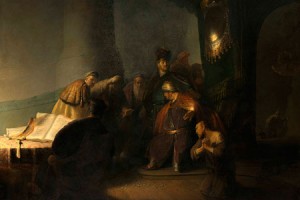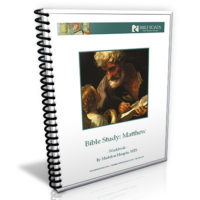If you admire others’ ability to draw, sketch, paint or sculpt, yet don’t seem to share those talents, welcome to my world of art appreciation instead. After all, artistic brilliance needs those who can treasure and reflect on their masterpieces.

Rembrandt’s “Judas Returning the Thirty Pieces of Silver”, currently on exhibit at The J.P. Morgan Library & Museum.
The Bible has long been the subject of some of the most monumental art through the centuries, affording art lovers plenty of opportunity for spiritual and aesthetic contemplation. Summer is a perfect time to focus on one tour de force just coming to light.
The J.P. Morgan Library in New York City has a current exhibit centered on a privately held Rembrandt often referred to as his first masterpiece, painted when just 23. Called Judas Returning the Thirty Pieces of Silver, it is breathtaking how precisely the Dutch master captures the dismissive priest following Judas’ betrayal of Christ Jesus.
When Judas, his betrayer, saw that Jesus was condemned, he repented and brought back the thirty pieces of silver to the chief priests and the elders. He said, “I have sinned by betraying innocent blood.” But they said, “What is that to us? See to it yourself.” Throwing down the pieces of silver in the temple, he departed; and he went and hanged himself (Matt. 27:3-5, NRSV).
In a single spurning gesture of the Priest’s left hand, Rembrandt captures the emotional drama felt by a man who realizes he has made the most damning misjudgment of his life: betrayal of the Messiah he loved.
A traveling diplomat, Constantijn Huygens, experienced the painting in 1629 of the young artist soon to become a master, and penned: “The gesture of that one despairing Judas…screaming, begging for forgiveness, but devoid of all hope. His gaze wild, his hair torn out by the roots, his garments rent, his arms contorted, his hands clenched until they bleed. A blind impulse has brought him to his knees, his whole body writhing in pitiful hideousness. All this I compare with all the beauty that has been produced throughout the ages. All honor to thee, Rembrandt!” (Letter by Huygens, excerpted in Morgan catalogue on exhibit.)
Students of Matthew’s Gospel, the only one in which Judas’ payment is mentioned, have long been familiar with the thirty pieces of silver the priests paid for being led to Jesus’ location during his prayerful preparation at Gethsemane. What may not be familiar is an Ex. 21:2 law describing property payment rights, the first time the ‘thirty shekels of silver’ is mentioned in the Bible.
32 If the ox gores a male or female slave, the owner shall pay to the slave owner thirty shekels of silver, and the ox shall be stoned.
The only other mention of ‘thirty shekels of silver’ (prior to Judas) is in the book of Zechariah. The prophet is told by God to act as the shepherd for the sheep portrayed as the recalcitrant people of Israel. But those ‘sheep’ don’t want to repent and therefore the shepherd (Zechariah) tells the people he quits, and asks for whatever wage they feel is appropriate.
12 I then said to them, “If it seems right to you, give me my wages; but if not, keep them.” So they weighed out as my wages thirty shekels of silver (Zech. 11:12).
The fact that Zechariah is given only ‘thirty shekels of silver’ is an insult, conjuring up the meager price of a male slave, described above in Exodus.
How does all this relate to Judas and the priests? Note that it was the Temple priests who negotiated the original payment:
Then one of the twelve, who was called Judas Iscariot, went to the chief priests and said, “What will you give me if I betray him to you?” They paid him thirty pieces of silver (Matt 26:14,15).
Expert in Jewish law, the Temple priests well knew of this reimbursement price of a slave from Exodus. In arrogant dismissal, they priced Jesus’ life at the same paltry rate. That Zechariah was God-directed to act as shepherd to the lost sheep of Israel, and paid the same remuneration, evokes the shepherding mantle Jesus bore as well.
The bottom line? Neither priest nor traitor could begin to grasp the Savior’s mission to redeem humanity from every ill that would beset it. That payment? Priceless.




Maddie, as usual, this article is informative, insightful, and sheds new light on familiar Bible text. Thank you!
Ah, Maddie, this brings a tear. Rembrandt’s Biblical paintings and drawings reveal a spiritual depth I do not find in other Masters. Thank you for bringing the OT connection to 30 pieces of silver to our attention. Your final word? A remarkable one-liner.
Beautiful article. I agree with Anabeth that it brings lots of depth to the Thirty Pieces of Silver. Poor Judas! And what a moving, dramatic painting.